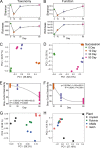Resilience and Assemblage of Soil Microbiome in Response to Chemical Contamination Combined with Plant Growth
- PMID: 30658982
- PMCID: PMC6414375
- DOI: 10.1128/AEM.02523-18
Resilience and Assemblage of Soil Microbiome in Response to Chemical Contamination Combined with Plant Growth
Abstract
A lack of knowledge of the microbial responses to environmental change at the species and functional levels hinders our ability to understand the intrinsic mechanisms underlying the maintenance of microbial ecosystems. Here, we present results from temporal microcosms that introduced inorganic and organic contaminants into agro-soils for 90 days, with three common legume plants. Temporal dynamics and assemblage of soil microbial communities and functions in response to contamination under the influence of growth of different plants were explored via sequencing of the 16S rRNA amplicon and by shotgun metagenomics. Soil microbial alpha diversity and structure at the taxonomic and functional levels exhibited resilience patterns. Functional profiles showed greater resilience than did taxonomic ones. Different legume plants imposed stronger selection on taxonomic profiles than on functional ones. Network and random forest analyses revealed that the functional potential of soil microbial communities was fostered by various taxonomic groups. Betaproteobacteria were important predictors of key functional traits such as amino acid metabolism, nucleic acid metabolism, and hydrocarbon degradation. Our study reveals the strong resilience of the soil microbiome to chemical contamination and sensitive responses of taxonomic rather than functional profiles to selection processes induced by different legume plants. This is pivotal to develop approaches and policies for the protection of soil microbial diversity and functions in agro-ecosystems with different response strategies from global environmental drivers, such as soil contamination and plant invasion.IMPORTANCE Exploring the microbial responses to environmental disturbances is a central issue in microbial ecology. Understanding the dynamic responses of soil microbial communities to chemical contamination and the microbe-soil-plant interactions is essential for forecasting the long-term changes in soil ecosystems. Nevertheless, few studies have applied multi-omics approaches to assess the microbial responses to soil contamination and the microbe-soil-plant interactions at the taxonomic and functional levels simultaneously. Our study reveals clear succession and resilience patterns of soil microbial diversity and structure in response to chemical contamination. Different legume plants exerted stronger selection processes on taxonomic than on functional profiles in contaminated soils, which could benefit plant growth and fitness as well as foster the potential abilities of hydrocarbon degradation and metal tolerance. These results provide new insight into the resilience and assemblage of soil microbiome in response to environmental disturbances in agro-ecosystems at the species and functional levels.
Keywords: functional reassembly; metagenomics; microbial resilience; plant invasion; response strategy; soil contamination; taxonomic levels.
Copyright © 2019 American Society for Microbiology.
Figures






Similar articles
-
Rhizosphere Microbial Response to Multiple Metal(loid)s in Different Contaminated Arable Soils Indicates Crop-Specific Metal-Microbe Interactions.Appl Environ Microbiol. 2018 Nov 30;84(24):e00701-18. doi: 10.1128/AEM.00701-18. Print 2018 Dec 15. Appl Environ Microbiol. 2018. PMID: 30291123 Free PMC article.
-
Comparison of microbial taxonomic and functional shift pattern along contamination gradient.BMC Microbiol. 2016 Jun 14;16(1):110. doi: 10.1186/s12866-016-0731-6. BMC Microbiol. 2016. PMID: 27301322 Free PMC article.
-
Metagenomic analysis of microbial community and function involved in cd-contaminated soil.BMC Microbiol. 2018 Feb 13;18(1):11. doi: 10.1186/s12866-018-1152-5. BMC Microbiol. 2018. PMID: 29439665 Free PMC article.
-
Revealing the hidden world of soil microbes: Metagenomic insights into plant, bacteria, and fungi interactions for sustainable agriculture and ecosystem restoration.Microbiol Res. 2024 Aug;285:127764. doi: 10.1016/j.micres.2024.127764. Epub 2024 May 15. Microbiol Res. 2024. PMID: 38805978 Review.
-
Metagenomics and plant-microbe symbioses: Microbial community dynamics, functional roles in carbon sequestration, nitrogen transformation, sulfur and phosphorus mobilization for sustainable soil health.Biotechnol Adv. 2025 Sep;82:108580. doi: 10.1016/j.biotechadv.2025.108580. Epub 2025 Apr 15. Biotechnol Adv. 2025. PMID: 40246210 Review.
Cited by
-
Inferring microbial co-occurrence networks from amplicon data: a systematic evaluation.mSystems. 2023 Aug 31;8(4):e0096122. doi: 10.1128/msystems.00961-22. Epub 2023 Jun 20. mSystems. 2023. PMID: 37338270 Free PMC article.
-
Microbial Interactions in Soil.Microorganisms. 2022 Sep 29;10(10):1939. doi: 10.3390/microorganisms10101939. Microorganisms. 2022. PMID: 36296215 Free PMC article.
-
Trends in Microbial Community Composition and Function by Soil Depth.Microorganisms. 2022 Feb 28;10(3):540. doi: 10.3390/microorganisms10030540. Microorganisms. 2022. PMID: 35336115 Free PMC article. Review.
-
Combined Phenanthrene and Copper Pollution Imposed a Selective Pressure on the Rice Root-Associated Microbiome.Front Microbiol. 2022 May 4;13:888086. doi: 10.3389/fmicb.2022.888086. eCollection 2022. Front Microbiol. 2022. PMID: 35602076 Free PMC article.
-
New-Generation Sequencing Technology in Diagnosis of Fungal Plant Pathogens: A Dream Comes True?J Fungi (Basel). 2022 Jul 16;8(7):737. doi: 10.3390/jof8070737. J Fungi (Basel). 2022. PMID: 35887492 Free PMC article. Review.
References
-
- Trenberth KE, Dai AG, van der Schrier G, Jones PD, Barichivich J, Briffa KR, Sheffield J. 2014. Global warming and changes in drought. Nat Clim Chang 4:17–22. doi:10.1038/nclimate2067. - DOI
-
- Callaway RM, Bedmar EJ, Reinhart KO, Silvan CG, Klironomos J. 2011. Effects of soil biota from different ranges on Robinia invasion: acquiring mutualists and escaping pathogens. Ecology 92:1027–1035. - PubMed
-
- Jiao S, Chen W, Wang J, Zhang L, Yang F, Lin Y, Wei G. 2018. Plant growth and oil contamination alter the diversity and composition of bacterial communities in agricultural soils across China. Land Degrad Dev 29:1660–1671. doi:10.1002/ldr.2932. - DOI
Publication types
MeSH terms
Substances
LinkOut - more resources
Full Text Sources

